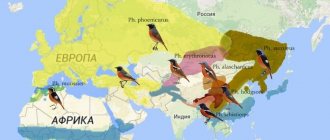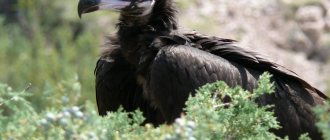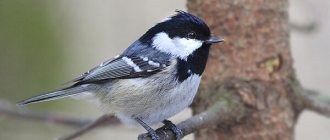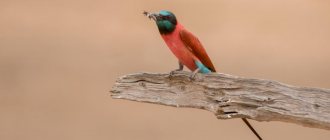| Latin name: | Carpodacus |
| English name: | To be confirmed |
| Kingdom: | Animals |
| Type: | Chordata |
| Class: | Birds |
| Squad: | Passeriformes |
| Family: | Finches |
| Genus: | Lentils |
| Body length: | 18 cm |
| Wing length: | 9 cm |
| Wingspan: | 20-25 cm |
| Weight: | 80 g |
Description of the bird
The lentil genus unites 22 species of birds of the finch family. All of them are distinguished by their bright melodic singing and the characteristic plumage of males. Lentils are also known as red sparrows, primarily due to their similar size. Adults usually weigh about 80 g, body length reaches 18 cm, wingspan, on average, about 20-25 cm. Females are slightly smaller than males. The color of the plumage of male lentils is royally rich: the purple head and neck turn into light pink back and abdomen, the wings and tail are soft brown. But females and young animals, alas, cannot boast of such beauty. All their feathers are colored olive with a brownish tint. Male lentils acquire their royal plumage only after their second molt.
Wintering birds of Russia: classifications, representatives
What birds remain to spend the winter in Russia? Approximately 70 species of birds remain. Let's clarify again. Wintering birds are considered to be those that remain in their native lands during the cold winter. Therefore, they know how to survive here and find food. After all, the bird will not freeze only if it is full. Therefore, those species that feed exclusively on insects fly away. And those who can eat berries, seeds, crumbs or predators remain.
Therefore, the birds were conditionally divided into several groups according to the type of food :
- herbivores
- omnivores
- predators
And also, according to the place of residence in winter, the following groups were identified:
- live in the city
- live in the forest
- live in the field
A bird trap is used to catch birds and keep them at home. Some species take root very easily at home, while others simply die in captivity. Therefore, a bird trap is sometimes useless and it is better to release some types of birds at once rather than torment them. In the next block we will consider in detail specific varieties of winter birds. Here are the most common:
Bullfinches, Crossbills, Jays, Crows, Pigeons, Waxwings, Nutwoods, Goldfinches, Muscovites, Sparrows, Siskins, Yellow-headed Kinglets, Woodpeckers, Tits, Nuthatches, Bee-eaters, Magpies, Eagle Owls, Owls, etc.
Nutritional Features
— Advertising —
Lentils are typical granivorous birds. Under natural conditions, they feed on seeds of wild grasses and trees. For example, they love dandelion seeds. They also forage for berries and, occasionally, insects. At home, they are not picky about food, but are prone to overeating and, as a result, to obesity.
Distribution in nature
Lentil species are very widespread in all latitudes of Eurasia. The bird is also found in North America. Its frequent nesting places are open spaces: meadows and woodlands located near water bodies. The bird usually hides in not too dense thickets, from where its melodic, expressive singing can be heard.
Features of wintering
— Advertising —
The lentil is a typical nomadic bird. In August-September, it migrates from northern latitudes to the southern regions of Asia. She always flies through Siberia, making a kind of circle, and returns the same way. That is why in the spring, lentils appear only closer to May, and immediately begin nesting.
Reproduction and lifespan
After wintering they return in early May. And they immediately begin building the nest. The lentil bird is monogamous, pairs are created for a long time. They are faithful to each other, the female stays close to her suitor. However, due to its conflicting nature, the male each time has to defend both his area and his half.
He boldly and selflessly takes away his chosen one and territory from other individuals. Meanwhile, my friend is building a nest. The husband is at war, the wife strengthens the family hearth. The nest is built from half a meter to two meters above the ground. Often a place is chosen that is atypical for other birds.
For example, they can arrange a nesting site in bunches of small alder branches (“witches’ brooms”), or among dense hop stems. It is built from leaves, grass, straw, climbing shoots, roots and other auxiliary material. The structure with a diameter of up to 16 cm looks untidy, loose, the ends of large stems stick out in different directions.
Lined with plant fluff or moss. There are no feathers in the nest, which makes it different from the nests of other birds. The nesting period is characterized by numerous “concerts” of males; at this time they talk and sing a lot, flying from branch to branch.
Moreover, about to burst into a trill, the singer gets ready - he fluffs his feathers, raises his crest, sits higher on a tree, sticks out his chest - and then a ringing song begins to flow. the voice of the lentil is murmuring and trilling, it is clear that the parent is rejoicing at returning from wintering, creating a new nest and the expected offspring.
At other times they are quite phlegmatic and prefer to keep quiet. During the summer, only one clutch is formed, in which no more than 6 eggs of a very interesting coloring: blue or slightly greenish in color with dark brown, purple or charcoal rowan. At the blunt end, these specks weave a pattern similar to a corolla.
The size of the eggs is from 19*13 to 22*16 mm, depending on the type of bird. One female incubates them, and after half a month the chicks hatch. Both parents feed the children. If you go by time, then at the beginning of June you can find full clutches, towards the end of June chicks appear in the nests, and after mid-July the flight from the parental home begins.
By the way, it is quite easy to find a nest; adult birds are restless and timid; they fly up when danger is imminent, and begin to fly restlessly over it. But getting to him is not so easy. You will have to fight with thickets and nettles, get stuck in swamps, and also make sure that the branches do not hurt your face.
Lentil bird nest with masonry
After the chicks fly away, the ancestors begin to lead an inconspicuous and modest life. You can’t hear the songs, they try to stay in the shadows. There is a feeling that the whole celebration of life lies in the production of offspring.
The parents “live out” the summer months, already slowly getting ready for the winter (migratory individuals). At this time, nests are difficult to detect, only sometimes you can hear the booming roll call of young individuals. Most often, lentils live 7-8 years, and in captivity, and with good maintenance, up to 12 years.
Species diversity
In total, the lentil genus includes 22 species.
Species of lentils have some plumage features, but, first of all, they differ in their habitat. Most of them inhabit various regions of Asia. But there are also exceptions. Thus, common lentils are a permanent resident of Europe. Mexican lentils are found in North America.
Common lentils
The common lentil is the most common, classic type of lentil with red-pink plumage in males and olive plumage in females and young animals. Found throughout Europe.
Juniper lentils
Distributed in Kazakhstan, the color of the male is distinguished by an exquisite pink hue with silver-gray splashes on the cheeks and forehead. The feathers of females and young males are dark brown with white edges. Juniper lentils are larger than ordinary ones, and they also have a longer tail.
Pale lentils
Pale lentils are also called Sinai lentils. This small bird with light yellow plumage, decorated with red and pink feathers, is the symbol of Jordan.
Large lentils
The large lentil, according to its name, is larger than its relatives: the body length of the bird is from 20 cm or more, the wing length is from 10 cm. That is, if the ordinary lentil is only slightly larger in size than a sparrow, then the large lentil resembles a thrush or starling. The plumage is also different - fluffy and long with silver spots on a pink-red background; the birds have a small crest on their heads. Three subspecies - Caucasian, Mongolian and Central Asian large lentils - inhabit different areas of Asia, according to their names.
Red-browed lentils
The red-browed lentil lives in the Himalayas and is distinguished by the cherry-red plumage of adult males.
Red finch
The species is also known as the rock lentil, as it is found only in the highlands of Central Asia at altitudes above 3000 m. The male has a purple rump and a bright red head and neck. The female is traditionally distinguished by a brown, modest robe with a greenish rump.
Mexican lentils
A type of North American lentil, which has more than 10 subspecies. All Mexicans are characterized by an unforked tail and a conical beak.
Pink lentils
The pink lentil is a sedentary bird that is found in Uzbekistan, Kazakhstan and the Tien Shan.
Siberian lentils
Siberian lentils are a resident of Eastern and Central Siberia. The females of this species are distinguished by the soft pink color of their feathers, and the males have variegated patterns on the wings and back.
Three-banded lentils
The three-banded lentil lives in the western regions of China, in light coniferous forests. The plumage is darker and richer than that of the common lentil.
In addition, there are:
- white-browed lentils,
- wine red lentils,
- highland lentils,
- beautiful lentils,
- red lentils,
- red cap lentils,
- purple lentils,
- spotted lentils,
- thin-billed lentils,
- Blanford lentils,
- Roborovsky lentils,
- Edwards lentils.
Male and female: main differences
Sexual dimorphism in lentils is very pronounced. The male can be easily recognized by his purple-red plumage, especially bright in the head and neck area. But the females look rather modest - their color varies from greenish to gray-brown.
Lentil shedding
The breeding period for large lentils begins in the second half of February - early March. Showing in birds is expressed in peculiar movements. The male presses his crest tightly to his head, lowers his wings, straightens his tail and turns from side to side, flapping his wings.
During mating, all movements of the males are accompanied by loud singing.
Breeding at home
To keep lentils, you need a spacious cage located in a well-lit place. It is recommended to have one bird or a pair of them, but it is better not to keep them together with other birds, as they may have conflicts.
At first, lentils at home can be skittish and restless. In such cases, the cage is covered with a light cloth. After the birds get used to their home, they can hatch chicks.
In one clutch, lentils usually have up to 5 light-colored eggs with brown specks. The female incubates them for two weeks, after which the chicks grow for about 20 more days.
The average lifespan of lentils is up to 8 years, and can reach 10-12 years.
Lifestyle and habitat
Nesting areas are primarily Central and Central Asia, including Siberia and the Urals, as well as Eastern Europe and the North American continent. You can often see them in the Anadyr region, on Sakhalin Island and Kamchatka. In the vast expanses of the former Soviet Union, birds are found almost everywhere, with the exception of Moldova and Transcarpathia. It populated many regions of India, China, Afghanistan, Iran, as well as the Caucasus.
These birds fly to the south of Asia for the winter. But among them there are species that do not fly anywhere for the winter and remain in place. These usually already live in warm regions. They are able to fly long distances, despite their modest size. You can unexpectedly see them in Malta, or in Sweden, and in the north of Holland.
They usually migrate in small flocks. They gather for the winter from the end of August, and return late, at the end of April or in May. For nesting they choose dense bushes in the meadow or overgrown areas of the forest. You can find such a bird at the edge of the forest, at the mouth of a river, in an abandoned cemetery or in old gardens. Some settle higher in the mountains.
Lentils live where there is dense foliage and water. They live quite secluded lives. Only at the time of nesting do they sing and talk, the rest of the time they remain very secretive. The flight to wintering occurs completely unnoticed, since their flocks are small.
The flight is swift and smooth. On the ground they move in small leaps. They move very deftly and quickly in dense thickets, clinging to branches with their claws, stepping and jumping. For those who are planning to get these birds, we recommend that they first cover their room (cage or aviary) with a light-colored cloth; they are very shy.
They must have at least ten hours of daylight, so the cage should be located close to the window. And in winter you need additional light. Usually they contain either one bird or a pair of them. But they must be kept separately from other birds; they can fight and quarrel with other species. After getting used to a new place, they can breed in captivity.
Feeding
Since lentils are granivorous birds, they are recommended to be fed with cereals, tree and herb seeds, small pieces of fruits and vegetables, and herbs. A real treat for lentils are bird cherry, juniper and hawthorn berries. Birds also need a lot of drinking water. To avoid excess weight in lentils, it is better to slightly underfeed them.
Interesting Facts:
- lentils are typical monogamous birds, after creating a pair, the female builds a nest and incubates the eggs, and the male gets food for her and the chicks;
- The complex nature of lentils is known - they do not get along well with other birds at home, and in nature the males get into real fights for territory;
- at home, lentils are prone to obesity, as they easily overeat, which is why it is advised to slightly underfeed the birds;
- Lentils are characterized by molting, so at home it is important to observe their daylight hours (at least 10 hours of daylight per day) and maintain an optimal diet.
Breeding period
Birds of this species can easily lead a sedentary lifestyle, but if the climate conditions of the habitat are not suitable for an all-season stay, they can both make short migrations and carry out seasonal flights.
Many facts about the life of these birds still remain unknown. No one has ever encountered places where these birds make nests, and there is also no evidence of the size and structure of the lentil nest. In addition, today there is no information about the behavior of these birds during the mating season, the model of social structure of life, the time of clutch formation, the type and size of eggs.
It is known that Siberian lentil chicks are born in the second half of June, and leave their nests closer to mid-July. During this period, young individuals were noticed that could fly quite well; by that time, the composition of the brood was already divided and the young individuals stayed alone. This fact was recorded in the area of Lake Oiskoye at the beginning of the 2nd decade of July, and was later confirmed on the Stanovoy Ridge in the second half of July.
common shrike - description, habitat, interesting facts











